Abstract
Over the last 50 years since Whittingham created the world’s first lithium-ion battery (LIB) in 1970, LIBs have continued to develop and have become mainstream for electric vehicle (EV) batteries. However, when an LIB for an EV reaches 80% of its state of health (SOH), although it still retains about 80% of its capacity, it is no longer suitable for use in general EVs and must be retired. This is problematic because not only is a retired LIB still viable for use and not totally obsolete, if not properly disposed of, a retired LIB may cause environmental pollution on top of being a waste of resources. Therefore, the reuse of retired LIBs from EVs is increasingly important. This paper uses circular economy (CE) and extended producer responsibility (EPR) as a theoretical basis to deal with the disposal of retired LIBs from EVs in Taiwan from legal, technical, and economic perspectives, and hopes to provide suggestions for the reuse of retired LIBs from EVs in Taiwan.
1. Introduction
In the 1990s, only the government and industry were interested in the disposal or recycling of lithium-ion batteries (LIBs) [1]. With the rapid electrification of the global transportion industry, LIBs have been widely used in electric vehicles (EVs) as the mainstream for EV batteries due to their high energy/power density, high reliability, and long service life. When an LIB for an EV reaches 80% of its state of health (SOH), it enters the end-of-life (EOL) stage and needs to be replaced. Therefore, it is expected that by 2025, 250,000 tons of LIBs for EVs will reach EOL [2]. In order to realize the maximum economic value of retired LIBs for EVs, the reuse of retired LIBs for EVs has become the most economical and environmentally friendly solution.
As LIBs for EVs reach their EOL, their recycling and reuse have become imperative. LIBs for EVs entering the EOL stage can be reused in a variety of applications that are less demanding. Since the reuse of LIBs can achieve better economic and environmental benefits, many “second life” LIBs for EV projects have begun to be developed, and have so far demonstrated the huge potential of the reuse of LIBs. However, technical challenges that must be faced in the reuse of LIBs include safety issues, assessment methods, screening and recombining techniques, and comprehensive management of the process.
Retirement is not disuse. Retired LIBs for EVs can be a waste of resources if they are not reused after they are removed from the EV. Since batteries typically account for 40 percent of the total cost of an EV, it is necessary to reuse them rather than simply dispose of them [2]. LIBs are already the mainstream batteries used in the current EV market, and this is no different in Taiwan. However, due to the development of EVs in Taiwan occurring relatively late, there are not many academic papers discussing the reuse of retired LIBs from EVs. Therefore, we hope that this paper will serve as a foundation that can lead to subsequent research on the recycling of LIBs from retired EVs in Taiwan.
Qualitative research and quantitative research are two important methods that are at the same level in terms of social science research [3,4,5]. This study will implement qualitative research using the “document analysis method” (literature qualitative analysis method) and “secondary data research method” mainly from external secondary data sources. This study will begins with a review of the literature after the introduction, followed by a description of the current development of EVs, a discussion of the reuse of retired batteries from EVs, and finally, conclusions and recommendations for the reuse of retired LIBs from EVs in Taiwan.
2. Literature Review
2.1. Development and Application of LIBs
A battery is a portable electrochemical device that can convert stored chemical energy into electrical energy with high efficiency without gas emissions [6,7,8]. The LIB was developed by Armand in the late 1970s, and after numerous performance optimization processes, the first commercialized LIBs appeared in 1991, manufactured by SONY [9]. LIBs have become an important part of the portable electronics field due to their unique characteristics of high energy capacity and long life [10,11].
Batteries for EVs can be divided into lead storage batteries, nickel–cadmium batteries, nickel–metal hydride batteries, and LIBs. Currently, LIBs are the mainstay of the market (i.e., the subject of this study), and in the future, the market will move towards fuel cells.
LIBs are batteries that store or discharge charge through the transfer of lithium-ions (Li+), and their charging and discharging operation is mainly accomplished through the migration of lithium-ions in and out of the anode and cathode materials. When charging, electrons (e−) are charged into the negative electrode material, while lithium-ions (Li+) are released from the positive electrode material. They are transported by the electrolyte and arrive at the negative electrode through the isolation membrane, and are then stored in the negative electrode material [12,13,14]. The opposite process occurs during discharge (see Figure 1 for details).
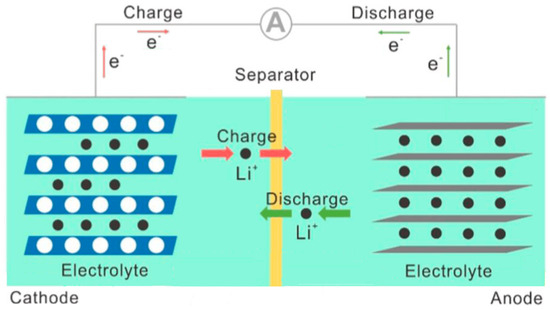
Figure 1.
Diagram of the LIB working principle. Source: Wang et al. (2023) [15]. Organized and charted by this study.
The conventional materials for LIB cathodes are transitional metal oxides with layered structures, such as LiCoO2 (LCO), LiMn2O4 (LMO), Li(NixCoyAlz)O2 (NCA), Li(NixCoyMnz)O2 (NCM), LiFePO4 (LFP), etc. [13,16,17], as shown in Figure 2.
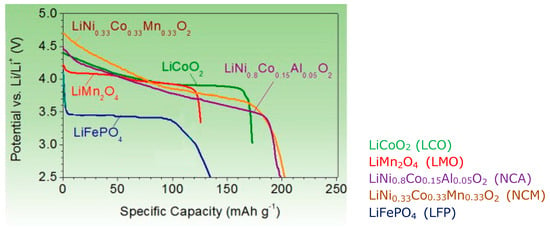
Figure 2.
Voltage curve graph of LIB electrode materials. Source: Nitta et al. (2015) [18]. Organized and charted by this study.
LIBs for vehicles are mainly used in EVs, PHEVs (plug-in hybrid EVs), BEVs (battery EVs), and electric agricultural tools [19]. The working voltage of lithium iron phosphate batteries for new cars is between 3.2 V and 3.4 V, and the capacity is between 120 mAh/g and 130 mAh/g. After 1000 cycles, its voltage drops to about 3.1 V to 3.2 V, and its capacity is between 70 mAh/g and 80 mAh/g. At this point, the batteries may no longer be able to provide the power needed for the vehicle and may become unusable, but may still be useful in other energy storage systems [20,21,22,23,24,25,26]. The following will elaborate on the technical and economic dimensions:
2.1.1. Technology Dimension
A typical LIB contains approximately 7% Co, 7% Li, 4% Ni, 5% Mn, 10% Cu, 15% Al, 16% graphite, and 36% other materials [27]. The reduced ability of LIBs to store electricity is mainly due to the formation of solid electrolytes during the charging and discharging cycles of the battery when the lithiated anode reacts with the alkyl carbonate in the electrolyte solution [28]. The resulting solid electrolyte interphase consists mainly of stable (such as Li2CO3) and metastable components (polymers, ROCO2Li, (CH2OCO2Li)2, and ROLi prone to decompose exothermically at >90 °C, releasing flammable gases and oxygen) [29] which are gradually deposited on the anode surface to form a passivated film. This film restricts the electrochemical reactions and increases in internal ohmic resistance.
The first use life of LIB packs for EVs is about 200,000 to 250,000 km [30]. When an EV battery pack loses about 20% of its initial capacity, it becomes unsuitable for towing, as the lower battery capacity affects a vehicle’s acceleration, range, and regeneration capacity [31]. Based on the key principle of “Refurbish, Reuse, Recycle” in the CE, the remaining 80% of the EV battery can still be used for “non-vehicle” applications [32,33]. For example, the new energy storage system installed at the Joahn Cruyff Arena in Amsterdam consists of 590 battery packs, of which 250 are used batteries from the 24 kWh battery packs of the EV [34]. This is a good example of the key principle of “reuse” in the CE.
The reuse of retired LIBs from EVs can provide significant economic benefits [35], and more and more companies are using second-life LIBs for residential, commercial and industrial applications [36]. According to the analysis performed by Melin, by 2025, about 75% of all retired EV batteries will be reused in second-life solutions for several years after originally being retired [37]. For example, 98 per cent of the lead–acid batteries that are being used for standby power in China Tower’s two million telecom tower sites will be replaced by reused lithium-ion batteries at a price comparable to that of new lead–acid batteries [38].
Lithium iron phosphate (molecular formula: LiFePO4, abbreviated as LFP) batteries will become the dominant lithium battery technology for EVs. Recently, a process has been discovered to recycle waste from LFP batteries into battery-grade (99 wt%) Li2CO3, which is ready for the manufacturing of new LFP batteries [39]. When the cathode waste is obtained with lithium iron phosphate powder attached to the aluminum foil, it is first separated from the soft pack batteries by first discharging and disassembling, and is then cut into small pieces. More than 99% of the Li is leached out, creating optimum conditions of 1.05 times the chemical measurement of persulfate. The high-purity (>99%) Li2CO3 in the spent LiFePO4 cells can be recovered directly by the simple addition of Na2CO3 into the leaching solution, followed by evaporation [34]. The above process delivers high-purity (>99.5%) lithium carbonate, solving the main problem that has been limiting LIB recycling, which is the long processing and purification process from raw material to cell-grade material [40].
2.1.2. Economic Dimension
Seven main components, i.e., cobalt (39%), lithium (16%), copper (12%), graphite (10%), nickel (9%), aluminum (5%), and manganese (2%), are reported to account for more than 90% of the economic value of discarded used LIBs [27]. Under ideal conditions, retired batteries could supply 60% of cobalt, 53% of lithium, 57% of manganese, and 53% of nickel globally by 2040 [41]. Regulations in China now holds EV producers responsible for battery recycling by requiring EV producers to set up recycling pipelines and service outlets to collect, store, and transfer old batteries to recycling companies [36].
In 2017, Chinese legislation was enacted to ban the importation of electronic waste, including batteries, leading to the establishment of new recycling plants overseas by Chinese companies that obtain lithium carbonate, cobalt, and nickel sulfate from retired batteries from large consumer electronics producers [36], as well as the opening of recycling plants in China by foreign EV battery producers [42].
Several other companies operate LIB recycling facilities around the world, including Singapore (TES-AMM), Seoul, the Republic of Korea (SungEel HiTech), Brussels, Belgium (Umicore), Lancaster, OH, USA and Trail, BC, Canada (Retriev Technologies), Laverton North, Australia (Envirostream Australia), Kilwinning, UK (Belmont Trading), etc., which are relatively small in scale but should not be overlooked [36].
Emerging green chemistry technologies will play a pivotal role in further mitigating recycling costs. Among the various green recycling processes, the battery recycling industry will, of course, lean towards the most economical and versatile options. After the development of a phosphoric acid/citric acid-based leaching process [43], it was compared with two other efficient and rapid metal recovery processes for leaching LiNixCoyMnzO2 cathode materials, namely, those using lactic acid [44] and hydrogen peroxide as well as malic [45] acid and hydrogen peroxide. The leaching temperatures, solid–liquid ratios, and leaching times were similar in all three processes. Therefore, the cost differences are mainly due to the price of raw materials, with the phosphoric/citric acid leaching process being about 30% less expensive than the malic acid process and 38% less expensive than the most expensive lactic acid process [43]. The cost-effectiveness of the phosphoric/citric acid method is attributed to its lower expense, rendering it the most widely adopted organic acid in this context [46].
2.2. Lithium Material Shortage and Reuse
Most of the existing literature focuses on cobalt and nickel, and there is less literature about lithium, the core element of LIBs. Due to the rapid growth of LIB usage, the lithium demanded by LIBs can only be provided until 2050. Therefore, countries such as China, the United States, and the European Union are increasingly more aware of the importance of recycling lithium [47]. However, unlike lead–acid batteries or other secondary batteries, LIBs do not have a uniform chemical composition, so the reuse of LIBs is more complicated and more costly than manufacturing them from virgin materials [48].
With the growth of global EV sales, the price of lithium carbonate (Li2CO3) has been continually increasing. After November 2020, the price of industrial-grade and battery-grade lithium carbonate rose sharply.
In November 2020, the cost of battery-grade lithium carbonate stood at RMB 44,200 (USD 6779) per ton; however, by November 2022, it had surged to RMB 578,173 (USD 86,284) per ton [49]. This represents an astonishing thirteen-fold price per ton increase in just a 2-year period. A visual representation of this rapid exponential growth is shown in Figure 3.
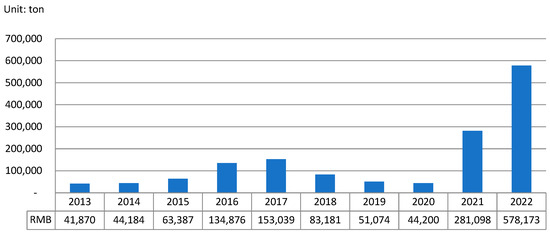
Figure 3.
Price growth chart of battery-grade lithium carbonate. Note: 2013: RMB 41,870≒USD 6864 (exchange rate: 6.1); 2014: RMB 44,184≒USD 7220 (exchange rate: 6.12); 2015: RMB 63,387≒USD 9767 (exchange rate: 6.49); 2016: RMB 134,876≒USD 19,407 (exchange rate: 6.95); 2017: RMB 153,039≒USD 22,276 (exchange rate: 6.59); 2018: RMB 83,181≒USD 12,108 (exchange rate: 6.87); 2019: RMB 51,074≒USD 7317 (exchange rate: 6.98); 2020: RMB 44,200≒USD 6779 (exchange rate: 6.52); 2021: RMB 281,098≒USD 44,198 (exchange rate: 6.36); 2022: RMB 578,173≒USD 86,294 (exchange rate: 6.7). Source: Organized and charted by this study.
With lithium prices tripling and cobalt prices quadrupling between 2016 and 2018, it became profitable to recycle lithium for valuable materials such as cobalt, manganese, and nickel from LIBs [36]. As a result, investments in recycling LIBs started to pour in, targeting LIBs from retired EVs. In its 2018 working document, the European Commission noted that “some companies have already started investing in the recycling of EV battery waste in Europe (e.g., Belgium and France). Some are already working with vehicle producers to collect and recycle batteries” [50].
From an environmental perspective, key criteria for enacting a CE include the repairability, upgradability, durability, and recyclability of products [51]. Consequently, the repurposing of retired EV batteries aligns with these criteria, as reuse is the best way to increase the total value and life of a battery. Retired batteries from vehicles that are not suitable for reuse as vehicle batteries can still be reused in other applications, such as in energy storage applications [23,52,53,54].
2.3. CE
The implementation of the CE model involves the actions of reducing, reusing, and recycling [55]. Undoubtedly, withing the context of a CE, reusing is a crucial component, and since this article focuses on the reuse of LIBs, it inherently adopts the priciples of CE.
One concept of CE is the sustainable and equitable reduction (and stabilization) in a society’s throughput, where throughput represents the materials and energy that a society extracts, processes, transports, distributes, consumes, and finally returns to the environment as waste [56]. It follows the idea that CE is a regenerative system designed to achieve the goal of reducing waste, materials, and energy cycles [57,58,59].
The sequential flow from Stage 1 to Stage 7 depicted in the Linear Economy Model shown in Figure 4 illustrates the life-cycle of goods and products in a very straightforward, direct way.
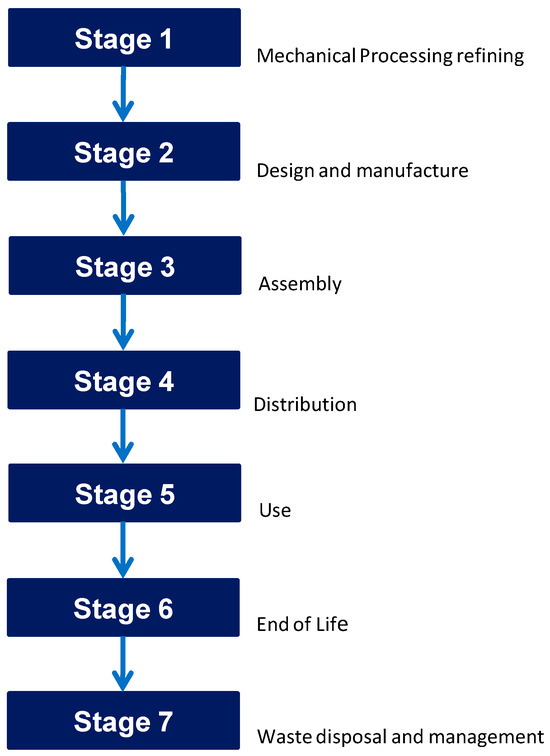
Figure 4.
Schematic diagram of the linear economy. Source: Organized and charted by this study.
When examining the linear economy through the lens of the circular economy (CE), particularly in the context of the “reuse economy”, a notable deviation occurs as the progression approaches Stage 6 (disposal/end of life). The conventional process is circumvented by incorporating recycling and introducing an additional 5-1 “Reuse Stage” before advancing to Stage 6 and, ultimately, Stage 7 (see Figure 5).
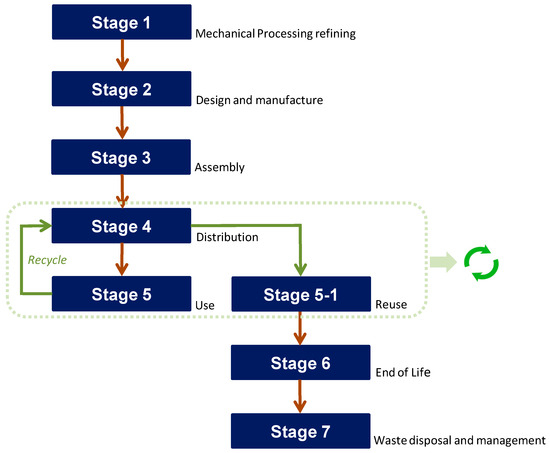
Figure 5.
Schematic diagram of CE reuse economy. Source: Organized and charted by this study.
Therefore, Stage 4 (distribution) is the point of reinsertion before Stage 5-1 (reuse), which is also the point of least resource consumption in the recycling process. This is also the point in the recycling process where the consumption of resources is minimized. In contrast to the linear economy, the focus of the CE cycle should be on the reuse economy as a return cycle [56].
The CE aims to mimic natural processes without generating waste. It is a regenerative approach aimed at reducing waste, and is designed to ensure the ecological sustainability of end of life (EOL) products. All stages of the CE are highly interdependent. For example, to achieve the CO2 reduction expected from LIBs, the energy produced should ideally come from renewable resources [57]. A CE approach for LIBs represents a core theme that has been analyzed in over 3000 studies conducted over the last 10 years and focuses on the main steps of CE [60].
In fact, because of their technical simplicity and economic viability, only aluminum, iron, and cobalt are currently targeted in the LIB recycling processes, while other compounds such as graphite and lithium are not [7]. Following the concepts of CE, the disposal and recycling of obsolete LIBs will be an urgent problem that will need to be solved by society, industry, and governments in the future. As LIBs become more ubiquitous in the world, it is very important to link LIBs with the CE. The focus of this study is on the “reuse” stage of LIBs, and we hope to increase the reuse of retired LIBs and achieve the CE goal of “from material to material”.
3. Disposal of Retired LIBs for EV
3.1. Current Situation of LIB Industry
3.1.1. Global LIB Industry
According to a report issued by Adamas Intelligence, the global shipment capacity of passenger car (commercial vehicle and others excluded) batteries, including BEV, PHEV, and HEV, will reach 286.2 GWh in 2021, representing a growth of 113% from that of the 134.5 GWh in 2020. The shipment capacities of the world’s top 10 vehicle battery producers reached 269.3 GWh, accounting for 94.1% of the total shipment capacity of 286.2 GWh, and the top 3 in terms of shipment capacities were CATL (87.8 GWh), LG Energy Solution (63.5 GWh), and Panasonic (41.4 GWh) [61]. (See Table 1).

Table 1.
2021 rankings of global passenger vehicle battery producers.
According to a report by the Japanese research firm Yano Research Institute (YRI), the global vehicle LIB market was 46.6 GWh in 2016 and was predicted to reach 371.1 GWh by 2021, a 120.9% jump from 2020. The global vehicle LIB market was expected to reach 443 GWh in 2022, up 19.4% from 2021. Additionally, according to the Japanese market research firm Fuji Keizai, the global market size for new EV/PHV vehicle sales is estimated to increase by approximately 740 percent by 2035 when compared to 2020 [63].
Vehicle safety is the main reason why LIBs are retired when they reach around 80% of their capacity or SOH. It is important to make the distinction that an LIB being retired does not equate to being discarded, and by embracing a “cradle to cradle” closed loop system in which waste does not leave, there will be a market for companies to process and reuse materials from retired LIBs. In fact, battery recycling start-up Li-Cycle estimates that 5 million tons of retired LIBs will be generated by 2030 [64].
3.1.2. The LIB Industry in Taiwan
According to Taiwan’s Ministry of Transportation and Communications (MOTC), the changes in the number of EV and hybrid vehicle (HV) registrations in Taiwan over the past 11 years from 2012 to 2022 are shown in Table 2 for cars and Table 3 for motorcycles.

Table 2.
Registration of EV and HV cars.

Table 3.
Registration of EV and HV motorcycles.
According to the Automotive Research and Testing Center (ARTC), Taiwan’s EV industry has grown significantly [65]. DIGITIMES Research estimates that power batteries will account for up to 80% of global LIB demand from 2024 onwards [63]. This is driven by the significant growth of overall EV sales, and Taiwan is no exception. The use of LIBs as a power source for EVs has become mainstream for clean energy.
3.2. Use of EV LIBs Has Become Mainstream
A 2021 report by the Japanese data company MarkLines stated that 4.5 million EVs would be sold worldwide in 2021, up 109% from 2020, and that the three countries of China, Germany, and the U.S. would account for 71.7% of global EV sales [66].
The data presented by MarkLines show that pure EVs overtook hybrids in global EV sales for the first time in 2021. In the U.S., pure EV sales reached 204,000 units between April and June 2022, also ahead of hybrids at 199,000 units [67]. The data provided by MarkLines at the time do indeed show that pure EVs were definitely slated to be the future of the market.
Chemical batteries are the most widely used in the field of EVs, and have become popular and commercialized. Chemical batteries can be divided into primary (non-rechargeable), secondary (rechargeable), and fuel cells (see Figure 6), and the type discussed in this article are secondary chemical batteries. Recent innovations in solid-state battery technology using solid electrolytes have begun to appear on the market, even threatening the competitive advantages of Tesla’s supercharging stations around the world, but they still face many difficulties in terms of manufacturing. In summary, batteries are the heart and power source of EVs, and the world is watching the development of EV batteries.
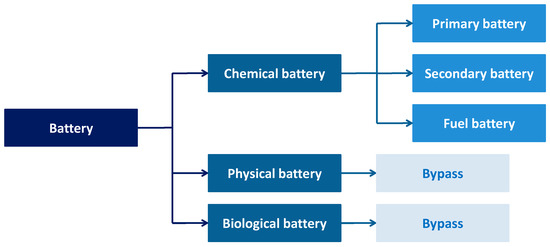
Figure 6.
Battery classification chart. Source: Organized and charted by this study.
3.3. Treatment of Retired Batteries for EVs
A retired battery can be “reused” (meaning reused for the “same” purpose) and is “slightly scrapped”, but a “reused” retired battery is different from a “severely scrapped” battery that cannot be “reused”. The treatment of retired batteries is shown in Figure 7.
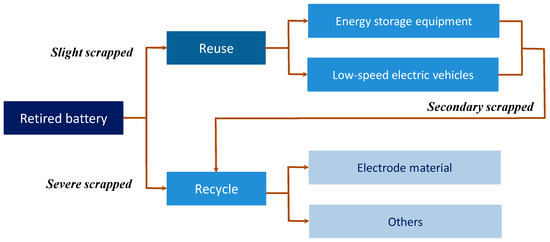
Figure 7.
Treatment process of retired batteries. Source: Organized and charted by this study.
When a vehicle battery reaches the end of its life, it is usually referred to as a vehicle battery reaching 80% of its state of health (SOH). At this point, although the vehicle battery still retains about 80% of its capacity, it is no longer suitable for use in general EVs and must be retired. However, because the retired batteries still have about 80–85% of their capacity [33,68], it is not economical to decommission them. In terms of the rational development process of “treat → recover → reuse → recycle →minimize → prevent” (see Figure 8), the reuse of retired vehicle batteries is still necessary.
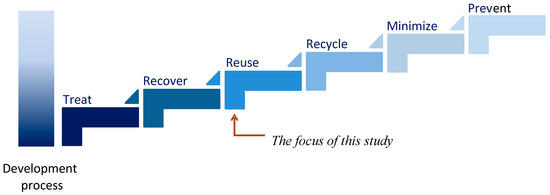
Figure 8.
Development process for handling retired batteries for vehicles. Source: Organized and charted by this study.
Even though they can no longer be used in EVs, retired batteries from vehicles can still be used for other applications. Around 10% of retired batteries from vehicles can be re-produced as vehicle batteries, around 70% can be used as static or high-capacity energy storage systems for grids or other general uses, and around 20% can be disassembled into modules or cells for smaller applications [69]. The treatment of retired batteries from vehicles will be a necessary issue in the future, such as using retired batteries from vehicles to reduce costs [53], to improve on the environmental impact of retired batteries from vehicles [70], for the design and analysis of retired batteries for vehicles in energy storage systems [71]), and for price changes [72] and business modeling [73,74,75].
4. Reuse Strategies of Retired LIBs for EVs in Taiwan
The annual growth rate of EVs worldwide in 2021 was 96.9% (see Figure 9), which was the largest growth rate in years [76]. LIBs are the dominant type of battery used in EVs or HVs, and breakthroughs and innovations have continued to be made in recent years [77,78].
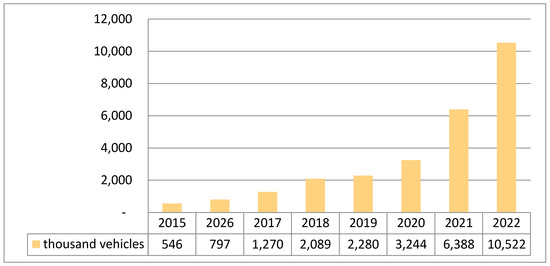
Figure 9.
Global EV market. Source: Chen (2022) [76]. Organized and charted by this study.
4.1. Treatment of Retired LIBs for EVs in Taiwan
If EVs are replaced or discarded, and if they are properly regenerated, the impact and harm to the environment can be reduced. On the other hand, domestic rare resources are scarce, so it is necessary to use the “urban mining” method, which is the process of recovering these rare metals through mechanical and chemical treatments. The name was coined in the 1980s by Professor Hideo Nanjyo of the Research Institute of Mineral Dressing and Metallurgy at Tohoku University, and the idea has gained significant traction in Japan in the 21st century to enhance the efficiency of resource utilization.
The number of scrapped EVs in the world today is small, and the amount of reuse is also small. However, the battery components of EVs have a high reuse value, and that reuse is a key issue. In this article, we will analyze Taiwan’s EV battery reuse strategy from legal, technical, and economic perspectives.
4.1.1. Legal Aspect
- The EV recycling system is not yet complete.
The Waste Recovery and Removal Audit Certification Practice Manual (specifically for motor vehicle waste) issued by the Environmental Protection Administration, Executive Yuan, Taiwan, available at https://epamotor.epa.gov.tw/Download/Document/, accessed on 19 February 2024, does not provide specific legal measures for the reuse of retired LIBs in vehicles.
- 2.
- Whether the recycling industry can deal with retired LIBs is still unclear.
LIBs for vehicles are made up of multiple battery cells. According to the definition of dry battery waste under the current regulations in Taiwan, is it possible for the waste car recycling industry to process and reuse retired LIBs for vehicles? There are still doubts.
- 3.
- Lack of regulations regarding the quantity of LIBs that can be recycled.
The Waste Recovery and Removal Audit Certification Practice Manual only regulates the reporting of tires, lead–acid batteries, lubricating oil, and refrigerants by the waste recycling industry, but there is a lack of a clear requirement to report the amount of LIBs recycled, let alone the amount of LIBs reused.
- 4.
- Incomplete LIB storage regulations.
There are currently no regulations for the temporary storage of LIBs for vehicle use. The electrolyte and lithium metal in LIBs are subject to very stringent environmental requirements, and improper storage can easily lead to industrial safety hazards, but the current regulations for LIB storage in the waste vehicle recycling industry are unclear.
4.1.2. Technical Aspect
- There is no technical manual for the disassembly of an EV LIB.
In Japan, vehicle producers are required to provide a manual for the recycling of drive batteries, e.g., The Honda Drive Battery Recycling Manual (https://www.honda.co.jp/auto-recycle/pdf/li_ion_common.pdf, accessed on 31 December 2022), but these types of relevant dismantling manuals have not yet been made available to the Taiwanese car waste recycling industry, which is problematic.
- There are difficulties for users in removing LIBs themselves.
Generally, waste dry batteries are small in size and easy to carry, so it is not difficult to reuse (recharge) them. The number of LIBs used in EVs is huge, and it is extremely difficult for users to remove them for reuse (recharge).
4.1.3. The Economic Aspect
- A.
- The feasibility of reusing retired LIBs is low.
LIBs from vehicles that reach their SOH threshold and have to be retired can still be used for second-hand parts, but there are concerns about the endurance of used LIBs, and therefore, the feasibility of reuse is reduced.
- B.
- Increased input costs for the sector or industry that processes retired
LIBs The reuse of LIBs from vehicles has inherent costs in terms of the dismantling process and investment in equipment and tools which are passed on to the retired LIB processor. However, these increased costs have the potential to diminish the willingness and motivation for the processors, as overall, it may become cost prohibitive, which can impact the effectiveness of reuse.
4.2. Introduction of Extended Producer Responsibility (EPR)
4.2.1. About EPR
At present, the most important method to solve the problem of solid waste management is EPR. EPR was first proposed by Swedish scholar Thomas Lindhqvist in a report submitted to the Swedish Ministry of the Environment in 1990 [79]. While individual recycling methods can reduce disposal costs through more environmental product design, collective recycling methods can increase operational cost efficiency [80]. Collective recycling methods have economies of scale, are simpler to implement, and provide convenient and diversified recycling channels; however, individual recycling methods are more effective in promoting environmental product design and environmental efficiency [81] (see Table 4 for details).

Table 4.
Advantages and disadvantages of different EPR implementation methods.
A multiplicity of policy instruments is more efficient when setting EPR policies and structures, and care should be taken to avoid monopolization of the market and to provide incentives for the environmental design of products [83]. A successful EPR system depends on the management of producers, and setting targets and monitoring producers’ finances and responsibilities are also key to the success of EPR, while financial incentives are an important mechanism for the success of the program [84]. Financial incentives are an important part of a successful program.
EPR is a concept developed in Europe, and is a dynamic policy instrument. The objective of this policy instrument is to encourage producers to prevent pollution and reduce resource use at every stage of a product’s life cycle through changes in product design and process technology. In addition, this can be achieved by producing products that are more rational and scalable to extend the life of the product, and by providing services instead of products. In summary, producer responsibility means that producers must take responsibility for the full environmental impact of their products.
4.2.2. EPR Is Part of Producer Responsibility
EPR is an environmental protection strategy to reach an environmental objective of a decreased total environmental impact of a product, by making the producer of the product responsible for the entire life-cycle of the product and especially for its take-back, recycling, and final disposal. Lindhqvist pointed out that producers must bear five responsibilities: environmental damage liability, economic responsibility, physical responsibility, ownership, and information responsibility [85]. This study believes that the connotation of ERP can be defined as the responsibility that producer-led responsible entities should bear for the recovery, recycling, and final disposal of waste generated from consumption and other links. Accordingly, EPR is the responsibility of producers for the recovery, recycling, and ultimate disposal of waste.
The EPR includes the following features:
- EPR emphasizes the producer as having the leading role based on the producer being responsible for the recycling, reclamation, and disposal of their product at the end of its life to better reduce waste and encourage recycling.
- EPR not only is the responsibility of producers, but also emphasizes the sharing of responsibilities among different players in the product’s entire life chain, including consumers, sellers, recyclers, and the government.
- The EPR system is an extension of producer responsibility, and its extended responsibility should be limited to the post-consumer recovery, recycling, and final disposal stages.
Policy instruments for the implementation of EPR can be categorized into three main types, which are regulatory instruments, economic instruments, and information instruments, as described below:
- A.
- Regulatory instruments.
Producers are legally responsible for all environmental damage and related processes during the life cycles of their products, and should therefore be regulated.
- B.
- Economic instruments.
The producer, including upstream, midstream, and downstream operators, must bear all or part of the costs associated with waste recycling, resource recovery, and waste disposal, which may be passed on in whole or in part to the cost of the product sold.
- C.
- Informative instruments.
Producers must inform consumers of all information relating to their product, including the composition of the raw materials, whether the processing has caused any damage to the environment, whether it is recyclable, how it can be reused, and the cost of clean-up.
In other words, in the spirit of EPR, although the Taiwanese government may not require producers to personally practice the disposal of LIBs from vehicles, the responsibility for the disposal of LIBs should be vested onto the motor vehicle producers.
4.2.3. Introducing EPR to Improve the Current System
The market for vehicle LIBs is more valuable than other parts and components. From a free market and economic perspective, the market for retired LIBs for vehicles is promising. According to the EU’s definition of EPR, the producer’s responsibility should extend to the product’s entire life cycle. Therefore, the producer must assume the responsibility of recycling, reclamation, and treatment after their product is used.
In Taiwan, the current system only controls tires, lead–acid batteries, lubricants, and refrigerants, and there is no control over the reuse of vehicle LIBs. Based on the considerations of the economic benefits, if there is no economic incentive to reuse vehicle LIBs, the industry, naturally, will be reluctant to reuse them. Since Taiwan does not clearly define producer responsibilities, it naturally cannot require vehicle producers to bear the responsibility for the disposal of LIBs used in their EVs. Based on this, Taiwan should uphold the spirit of extended producer responsibility and require vehicle producers to take responsibility for the disposal of LIBs from their EVs. However, extended producer responsibility will result in additional costs and burdens for producers, and the existing interests of producers and market benefits should be taken into account when determining the scope of their responsibility.
To establish the role and responsibility of vehicle producers in handling LIBs for vehicles, relevant laws should be enacted to define the responsibilities of handling LIBs from vehicles as a legal liability, so that the handling of LIBs from vehicles can be strictly controlled. In addition, the methods of dismantling and storing LIBs should be clearly defined as described below:
- A.
- Establishing an EV LIB recycling notification system.
The waste motor vehicle recycling trade is required to register the inventory of recovered waste in the “Waste Motor Vehicle Scrap Recycling System” before the 5th of each month for review by the Resource Recovery Management Fund Management Committee of the Environmental Protection Department. However, at this stage, there is no requirement for any declaration on the reuse of vehicle LIBs.
- B.
- Revision of the current facility standard.
LIBs in vehicles still have residual power after being discharged, and the retired LIB processor does not have the corresponding treatment technology. Therefore, there is a need to revise the “Waste Motor Vehicle Recycling, Storage, Removal and Treatment Standard” (hereinafter referred to as the “Facility Standard”) as the standard specification for facilities that reuse LIBs from vehicles.
- C.
- Counseling traders who are not eligible for subsidies to join.
To ensure that retired LIBs from vehicles are properly disposed of in the future, we should actively assist retired LIB processors in joining Taiwan’s waste motor vehicle waste auditing system. In this way, the EPA will be able to keep track of the current status of the reuse of retired LIBs.
5. Conclusions and Recommendations
LIBs for vehicles have become the mainstream. The concept of EPR has been introduced internationally, requiring producers to take responsibility for the reuse of retired LIBs. In addition to being reusable, the precious metals in retired LIBs have a high market value. In this paper, we analyzed the strategies for reusing batteries for EVs in Taiwan from the regulatory, technical, and economic perspectives to properly handle retired LIBs for vehicles, in the hopes of establishing a reuse system for LIBs from vehicles in Taiwan.
After analysis, since the current market share of EVs is not very high, in addition to a lack of regulations in Taiwan, the introduction of a treatment technology to deal with retired LIBs from EVs is not enough to cover the costs. Therefore, concerning the spirit of CE and ERP, this paper suggests that Taiwan should develop a treatment method different from the current system so that producers can shoulder their corporate social responsibility (CSR) and reuse retired LIBs from EVs voluntarily. The government can take a backseat and play a supervisory role to achieve a win–win–win situation for the economy, society, and the environment.
Compared with other advanced countries, the development of EVs is relatively late in Taiwan, and there is no large-scale process to deal with retired LIBs as of yet. However, when LIBs are retired in the very near future, they are bound to be some problems in terms of their reuse. Therefore, this paper proposes the following recommendations for the future reuse of retired LIBs from vehicles, which will serve as a basis for future studies.
- A.
- Regulatory aspect.
Amendments should be made towards the recovery, preservation, transportation, management methods, and facility standards for mobile transport vehicles to raise the reuse rates of removable retired LIBs from EVs and to increase the special maintenance cost rates for the addition of detachable batteries in retired vehicles.
- B.
- Technical aspect.
The EPA should conduct education and training courses, actively cultivate qualified operators, and stipulate in the “Operation Manual for Certification of Waste Recovery and Removal Processes (Waste Motor Vehicles—Recycling Industry)” that LIBs at their end of life from EVs should be dismantled by qualified operators.
- C.
- Economic aspect.
The reuse of retired LIBs from EVs is a clear indication of their economic benefits. Based on the concept of EPR, the reuse of retired LIBs should not be carried out by the producer itself, but by the entities or enterprises the specialize in processing retired LIBs to create co-benefits.
Author Contributions
Conceptualization and methodology, Y.-S.C., H.-P.C. and C.-C.C.; formal analysis and investigation, Y.-S.C.; writing, Y.-S.C. and C.-C.C. All authors have read and agreed to the published version of the manuscript.
Funding
This research received no external funding.
Institutional Review Board Statement
Not applicable.
Informed Consent Statement
Not applicable.
Data Availability Statement
The data presented in this study are available on request from the corresponding author. The data are not publicly available due to privacy.
Conflicts of Interest
The authors declare no conflicts of interest.
References
- Georgi-Maschler, T.; Friedrich, B.; Weyhe, R.; Heegn, H.; Rutz, M. Development of a recycling process for Li-ion batteries. J. Power Source 2012, 207, 173–182. [Google Scholar] [CrossRef]
- Shahjalal, M.; Roy, P.K.; Shams, T.; Fly, A.; Chowdhury, J.I.; Ahmed, M.R.; Liu, K. A review on second-life of Li-ion batteries: Prospects, challenges, and issues. Energy 2022, 241, 122881. [Google Scholar] [CrossRef]
- Djafar, H.; Yunus, R.; DJ Pomalato, S.W.; Rasid, R. Qualitative and quantitative paradigm constellation in educational research methodology. Int. J. Educ. Res. Soc. Sci. IJERSC 2021, 2, 339–345. [Google Scholar] [CrossRef]
- Mehrad, A.; Zangeneh, M.T. Comparison between qualitative and quantitative research approaches: Social sciences. Int. J. Res. Educ. Stud. 2019, 5, 1–7, ISSN 2208-2115. [Google Scholar]
- Bernard, H.R. Social Research Methods: Qualitative and Quantitative Approaches; SAGE Publications, Inc.: New York, NY, USA, 2013. [Google Scholar]
- Mossali, E.; Picone, N.; Gentilini, L.; Rodrìguez, O.; Pérez, J.M.; Colledani, M. Lithium-ion batteries towards circular economy: A literature review of opportunities and issues of recycling treatments. J. Environ. Manag. 2020, 264, 110500. [Google Scholar] [CrossRef] [PubMed]
- Velázquez-Martínez, O.; Valio, J.; Santasalo-Aarnio, A.; Reuter, M.; Serna-Guerrero, R. A critical review of lithium-ion battery recycling processes from a circular economy perspective. Batteries 2019, 5, 68. [Google Scholar] [CrossRef]
- Scrosati, B.; Hassoun, J.; Sun, Y.-K. Lithium-ion batteries. A look into the future. Energy Environ. Sci. 2011, 4, 3287–3295. [Google Scholar] [CrossRef]
- Blomgren, G.E. The development and future of lithium ion batteries. J. Electrochem. Soc. 2017, 164, A5019–A5025. [Google Scholar] [CrossRef]
- Reddy, B.T. Linden’s Handbook of Batteries, 4th ed.; McGraw Hill: New York, NY, USA, 2011; ISBN 9780071624213. [Google Scholar]
- Tarascon, J.M.; Armand, M. Issues and challenges facing rechargeable lithium batteries. Nature 2001, 414, 359–367. [Google Scholar] [CrossRef] [PubMed]
- Rui, J.-W. An Overview of Current Mainstream Electric Vehicle Batteries from Battery Types. North America Intellectual Property (NAIP) eNewsletter. 23 June 2021, p. 287. Available online: http://www.naipo.com/Portals/1/web_tw/Knowledge_Center/Industry_Economy/IPNC_210623_0705.htm (accessed on 1 January 2024).
- Rallo, H.; Benveniste, G.; Gestoso, I.; Amante, B. Economic analysis of the disassembling activities to the reuse of electric vehicles Li-ion batteries. Resour. Conserv. Recycl. 2020, 159, 104785. [Google Scholar] [CrossRef]
- Deng, D. Li-ion batteries: Basics, progress, and challenges. Energy Sci. Eng. 2015, 3, 385–418. [Google Scholar] [CrossRef]
- Wang, X.; Zhang, Y.; Deng, Y.; Yuan, Y.; Zhang, F.; Lv, S.; Zhu, Y.; Ni, H. Effects of different charging currents and temperatures on the voltage plateau behavior of li-ion batteries. Batteries 2023, 9, 42. [Google Scholar] [CrossRef]
- Wang, W.; Wu, Y. An overview of recycling and treatment of spent LiFePO4 batteries in China. Resour. Conserv. Recycl. 2017, 127, 233–243. [Google Scholar] [CrossRef]
- Wang, Q.; Mao, B.; Stoliarov, S.I.; Sun, J. A review of lithium ion battery failure mechanisms and fire prevention strategies. Prog. Energy Combust. Sci. 2019, 73, 95–131. [Google Scholar] [CrossRef]
- Nitta, N.; Wu, F.; Lee, J.T.; Yushin, G. Li-ion battery materials: Present and future. Mater. Today 2015, 18, 252–264. [Google Scholar] [CrossRef]
- Diouf, B.; Pode, R. Potential of lithium-ion batteries in renewable energy. Renew. Energy 2015, 76, 375–380. [Google Scholar] [CrossRef]
- Phophongviwat, T.; Polmai, S.; Maneeinn, C.; Hongesombut, K.; Sivalertporn, K. Technical assessment of reusing retired electric vehicle lithium-ion batteries in Thailand. World Electr. Veh. J. 2023, 14, 161. [Google Scholar] [CrossRef]
- Hua, Y.; Liu, X.; Zhou, S.; Huang, Y.; Ling, H.; Yang, S. Toward sustainable reuse of retired lithium-ion batteries from electric vehicles. Resour. Conserv. Recycl. 2021, 168, 105249. [Google Scholar] [CrossRef]
- Bobba, S.; Mathieux, F.; Blengini, G.A. How will second-use of batteries affect stocks and flows in the EU? A model for traction Li-ion, Resources. Conserv. Recycl. 2018, 145, 279–291. [Google Scholar] [CrossRef]
- Ahmadi, L.; Yip, A.; Fowler, M.; Young, S.B.; Fraser, R.A. Environmental feasibility of re-use of electric vehicle batteries. Sustain. Energy Technol. Assess. 2014, 6, 64–74. [Google Scholar] [CrossRef]
- Poullikkas, A. A comparative overview of large-scale battery systems for electricity storage. Renew. Sustain. Energy Rev. 2013, 27, 778–788. [Google Scholar] [CrossRef]
- Keeli, A.; Sharma, R.K. Optimal use of second life battery for peak load management and improving the life of the battery. In Proceedings of the 2012 IEEE International Electric Vehicle Conference, Greenville, SC, USA, 4–8 March 2012. [Google Scholar] [CrossRef]
- Hall, P.J.; Bain, E.J. Energy-storage technologies and electricity generation. Energy Policy 2008, 36, 4352–4355. [Google Scholar] [CrossRef]
- Kochhar, A.; Johnston, T.G. A Process, Apparatus, and System for Recovering Materials from Batteries. Patent WO2018218358A1, 2018. [Google Scholar]
- Vetter, J.; Novák, P.; Wagner, M.R.; Veit, C.; Möller, K.-C.; Besenhard, J.O.; Winter, M.; Wohlfahrt-Mehrens, M.; Vogler, C.; Hammouche, A. Ageing mechanisms in lithium-ion batteries. J. Power Source 2005, 147, 269–281. [Google Scholar] [CrossRef]
- Liu, K.; Liu, Y.; Lin, D.; Pei, A.; Cui, Y. Materials for lithium-ion battery safety. Sci. Adv. 2018, 4, eaas9820. [Google Scholar] [CrossRef] [PubMed]
- Gao, Y.; Jiang, J.; Zhang, C.; Zhang, W.; Ma, Z.; Jiang, Y. Lithium-ion battery aging mechanisms and life model under different charging tresses. J. Power Source 2017, 356, 103–114. [Google Scholar] [CrossRef]
- Saxena, S.; Le Floch, C.; MacDonald, J.; Moura, S. Quantifying EV battery end-of-life through analysis of travel needs with vehicle powertrain models. J. Power Source 2015, 282, 265–276. [Google Scholar] [CrossRef]
- Hua, Y.; Zhou, S.; Huang, Y.; Liu, X.; Ling, H.; Zhou, X.; Zhang, C.; Yang, S. Sustainable value chain of retired lithium-ion batteries for electric vehicles. J. Power Source 2020, 478, 228753. [Google Scholar] [CrossRef]
- Sanghai, B.; Sharma, D.; Baidya, K.; Raja, M. Refurbished and Repower: Second Life of Batteries from Electric Vehicles for Stationary Application; SAE International Technical Paper 2019-26-0156; SAE International: Warrendale, PA, USA, 2019. [Google Scholar] [CrossRef]
- Robb, J. Making Stadiums and Arenas More Resilient and Energy Efficient. Publication No. WP701001EN/CSSC-868, (White Paper); Eaton xStorage Buildings: Morges, Switzerland, March 2018. [Google Scholar]
- Ran, A.; Liang, Z.; Chen, S.; Cheng, M.; Sun, C.; Ma, F.; Wang, K.; Li, B.; Zhou, G.; Zhang, X.; et al. Fast Clustering of Retired Lithium-Ion Batteries for Secondary Life with a Two-Step Learning Method. ACS Energy Lett. 2022, 7, 3817–3825. [Google Scholar] [CrossRef]
- Pagliaro, M.; Meneguzzo, F. Lithium battery reusing and recycling: A circular economy insight. Heliyon 2019, 5, e01866. [Google Scholar] [CrossRef]
- Melin, H.E. The Lithium-Ion Battery End-of-Life Market 2018–2025; Circular Energy Storage: London, UK, 2018. [Google Scholar]
- Jiao, N. China Tower ‘Can Absorb’ 2 Million Retired Electric Vehicle Batteries. Available online: http://www.Idtechex.com (accessed on 27 September 2018).
- Zhang, J.; Hu, J.; Liu, Y.; Jing, Q.; Yang, C.; Chen, Y.; Wang, C. Sustainable and facile method for the selective recovery of lithium from cathode scrap of spent LiFePO4 batteries. ACS Sustain. Chem. Eng. 2019, 7, 5626–5631. [Google Scholar] [CrossRef]
- Battery University. BU-705a: Battery Recycling as a Business. 28 February 2019. Available online: https://batteryuniversity.com/learn/article/battery_recycling_as_a_business (accessed on 1 January 2024).
- Dunn, J.; Slattery, M.; Kendall, A.; Ambrose, H.; Shen, S. Circularity of lithium-ion battery materials in electric vehicles. Environ. Sci. Technol. 2021, 55, 5189–5198. [Google Scholar] [CrossRef]
- Jung, M.-H. SK Innovation to Enter Chinese EV Battery Recycling Market. Business Korea. Available online: https://www.businesskorea.co.kr/news/articleView.html?idxno=27009 (accessed on 29 November 2018).
- Zhuang, L.; Sun, C.; Zhou, T.; Li, H.; Dai, A. Recovery of valuable metals from LiNi0.5Co0.2Mn0.3O2 cathode materials of spent Li-ion batteries using mild mixed acid as leachant. Waste Manag. 2019, 85, 175–185. [Google Scholar] [CrossRef]
- Li, L.; Fan, E.; Guan, Y.; Zhang, X.; Xue, Q.; Wei, L.; Wu, F.; Chen, R. Sustainable recovery of cathode materials from spent lithium-ion batteries using lactic acid leaching system. ACS Sustain. Chem. Eng. 2017, 5, 5224–5233. [Google Scholar] [CrossRef]
- Sun, C.; Xu, L.; Chen, X.; Qiu, T.; Zhou, T. Sustainable recovery of valuable metals from spent lithium-ion batteries using DL-malic acid: Leaching and kinetics aspect. Waste Manag. Res. 2018, 36, 113–120. [Google Scholar] [CrossRef]
- Ciriminna, R.; Meneguzzo, F.; Delisi, R.; Pagliaro, M. Citric acid: Emerging applications of key biotechnology industrial product. Chem. Cent. J. 2017, 11, 22. [Google Scholar] [CrossRef]
- Wanger, T.C. The lithium future—Resources, recycling, and the environment. Conserv. Lett. 2011, 4, 202–206. [Google Scholar] [CrossRef]
- Patel, P.; Gaines, L. Recycling Li batteries could soon make economic sense. MRS Bull. 2016, 41, 430–431. [Google Scholar] [CrossRef]
- Yeh, W.-Y. Land Battery-Grade Lithium Carbonate Prices Soar. Economic Times. Available online: https://money.udn.com/money/story/5604/6738063 (accessed on 4 November 2022).
- European Commission. Report on Raw Materials for Battery Applications. SWD 245 Final, Brussels. Available online: https://www.kowi.de/Portaldata/2/Resources/horizon2020/coop/2018-SWD-Report-Raw-Materials-Battery-Applications.pdf (accessed on 17 May 2018).
- Ruiz, V.; Di Persio, F. Standards for the Performance and Durability Assessment of Electric Vehicle Batteries; EUR 29371 EN; Publications Office: Luxembourg, 2018; ISBN 978-92-79-94179-5. ISSN 1831-9424. [Google Scholar] [CrossRef]
- Heymans, C.; Walker, S.B.; Young, S.B.; Fowler, M. Economic analysis of second use electric vehicle batteries for residential energy storage and load-leveling. Energy Policy 2014, 71, 22–30. [Google Scholar] [CrossRef]
- Neubauer, J.S.; Pesaran, A.; Williams, B.; Ferry, M.; Eyer, J. A techno-economic analysis of PEV battery second use: Repurposed-battery selling price and commercial and industrial end-user value. In Proceedings of the SAE World Congress, Detroit, MI, USA, 24–26 April 2012. [Google Scholar] [CrossRef]
- Neubauer, J.S.; Pesaran, A. The ability of battery second use strategies to impact plug-in electric vehicle prices and serve utility energy storage applications. J. Power Source 2011, 196, 10351–10358. [Google Scholar] [CrossRef]
- Araujo-Morera, J.; Verdejo, R.; López-Manchado, M.A.; Santana, M.H. Sustainable mobility: The route of tires through the circular economy model. Waste Manag. 2021, 126, 309–322. [Google Scholar] [CrossRef] [PubMed]
- Kallis, G. In defense of degrowth. Ecol. Econ. 2011, 70, 873–880. [Google Scholar] [CrossRef]
- Hawkins, T.R.; Singh, B.; Strømman, A.H.; Majeau-Bettez, G.; Majeau-Bettez, G. Comparative environmental life cycle assessment of conventional and electric vehicles. J. Ind. Ecol. 2012, 17, 53–64. [Google Scholar] [CrossRef]
- Geissdoerfer, M.; Savaget, P.; Bocken, N.; Hultink, E. The circular economy—A new sustainability paradigm? J. Clean. Prod. 2017, 143, 757–768. [Google Scholar] [CrossRef]
- Winans, K.; Kendall, A.; Deng, H. The history and current applications of the circular economy concept. Renew. Sustain. Energy Rev. 2017, 68, 825–833. [Google Scholar] [CrossRef]
- Yun, L.; Linh, D.; Shui, L.; Peng, X.; Garg, A.; LE, M.L.P.; Asghari, S.; Sandoval, J. Metallurgical and mechanical methods for recycling of lithium-ion battery pack for electric vehicles. Resour. Conserv. Recycl. 2018, 136, 198–208. [Google Scholar] [CrossRef]
- Wu, G. [U-EV] 2021 Global Automotive Battery Market Share Ranking Released, CATL Takes No. 1. U-CAR News. 11 February 2022. Available online: https://news.u-car.com.tw/news/article/69402 (accessed on 1 January 2024).
- Kane, M. Global Passenger xEV Battery Market Doubled in 2021: 286 GWh. InsideEvs. 10 February 2022. Available online: https://insideevs.com/news/566626/global-xev-battery-market-2021 (accessed on 1 January 2024).
- Tsai, C.-C. The market size of lithium batteries for vehicles is expected to double in 2019, with electric vehicles accounting for 90%. MoneyDJ News, 2 August 2022. [Google Scholar]
- Li-Cycle. Li-Cycle leads the recycling of lithium-ion batteries with high resource recovery technology. IN THE NEWS, 6 January 2022; Original article published in TechBlitz. [Google Scholar]
- Huang, L.-J. Taiwan Power Lithium Battery Energy Development Status and Challenges; Automotive Research & Testing Center (ARTC): Taipei, Taiwan, 2011; Available online: https://www.thenewslens.com/article/165763 (accessed on 1 January 2024).
- Deng, G.-W. 2021 Global Electric Car Aales Out of the Furnace! Tesla Took the Championship Not Unexpectedly Japanese 2 Big Factory Ranking Countdown. ETtoday Speed. 26 March 2022. Available online: https://speed.ettoday.net/news/2216444#ixzz7mkPnMcES (accessed on 1 January 2024).
- Chang, C.-Y. The First Half of 2022 Global Electric Car Sales Tesla Steadily Sat in the First Place, Hyundai, Kia Group Rose to the Top 5. U-Car. 1 August 2022. Available online: https://news.u-car.com.tw/news/article/71607 (accessed on 1 January 2024).
- Omar, N.; Monem, M.A.; Firouz, Y.; Salminen, J.; Smekens, J.; Hegazy, O.; Gaulous, H.; Mulder, G.; Van den Bossche, P.; Coosemans, T.; et al. Lithium iron phosphate based battery—Assessment of the aging parameters and development of cycle life model. Appl. Energy 2014, 113, 1575–1585. [Google Scholar] [CrossRef]
- Casals, L.C.; García, B.A.; Cremades, L.V. Electric vehicle battery reuse: Preparing for a second life. J. Ind. Eng. Manag. 2017, 10, 266–285. [Google Scholar] [CrossRef]
- Casals, L.C.; García, B.A.; Aguesse, F.; Iturrondobeitia, A. Second life of electric vehicle batteries: Relation between materials degradation and environmental impact. Int. J. Life Cycle Assess. 2017, 22, 82–93. [Google Scholar] [CrossRef]
- Catton, J.W.A.; Walker, S.B.; McInnis, P.; Fowler, M.; Fraser, R.A.; Young, S.B.; Gaffney, B. Design and analysis of the use of re-purposed electric vehicle batteries for stationary energy storage in Canada. Batteries 2019, 5, 14. [Google Scholar] [CrossRef]
- Sun, S.I.; Chipperfield, A.J.; Kiaee, M.; Wills, R.G.A. Effects of market dynamics on the time-evolving price of second-life electric vehicle batteries. J. Energy Storage 2018, 19, 41–51. [Google Scholar] [CrossRef]
- Jiao, N.; Evans, S. Business models for sustainability: The case of second-life electric vehicle batteries. Procedia CIRP 2016, 40, 250–255. [Google Scholar] [CrossRef]
- Jiao, N.; Evans, S. Business models for repurposing a second-life for retired electric vehicle batteries. In Behaviour of Lithium-Ion Batteries in Electric Vehicles—Battery Health, Performance, Safety, and Cost; Pistoia, G., Liaw, B., Eds.; Springer: Cham, Switzerland, 2018; p. 323. [Google Scholar] [CrossRef]
- Bräuer, S.; Monhof, M.; Klör, B.; Plenter, F.; Beverungen, D.; Siemen, C. Residential energy storage from repurposed electric vehicle batteries: Market overview and development of a service-centered business model. In Proceedings of the 2016 IEEE 18th Conference on Business Informatics (CBI), Paris, France, 29 August–1 September 2016; pp. 143–152. [Google Scholar] [CrossRef]
- Chen, K. Electric Vehicle Growth Differs Significantly from Estimates, 2022 Estimates Still Conservative. 8 February 2022. Available online: https://iea.blob.core.windows.net/assets/ad8fb04c-4f75-42fc-973a-6e54c8a4449a/GlobalElectricVehicleOutlook2022.pdf (accessed on 19 February 2024).
- Department of Energy and Climate Change (DECC). Energy Trend; A National Statistics Publication; DECC: London, UK, 2013. [Google Scholar]
- Huang, K.-L.; Wang, S.-C.; Liu, S.-C. Principles and Technology of Lithium-Ion Batteries; Wunan: Taipei, Taiwan, 2010; ISBN 9789571159683. [Google Scholar]
- Lindhqvist, T. Extended Producer Responsibility in Cleaner: Production Policy Principle to Promote Environmental Improvements of Product Systems; The International Institute for Industrial Environmental Economics, Lund University: Lund, Sweden, 2000. [Google Scholar]
- Atasu, A.; Subramanian, R. Extended producer responsibility for E-Waste: Individual or collective producer responsibility. Prod. Oper. Manag. 2012, 21, 1042–1059. [Google Scholar] [CrossRef]
- Lambert, J. The Influence of Extended Producer Responsibility on Eco-Design Practices: Insights from Six Producer Case Studies in the European ICT Sector. Master’s Thesis, Utrecht University, Utrecht, The Netherlands, 2012. Available online: https://studenttheses.uu.nl/handle/20.500.12932/15667 (accessed on 1 January 2024).
- Pegels, A.; Heyer, S.; Ohlig, D.; Kurz, F.; Laux, L.; Morley, P. How Sustainable Is Recycling? Reconciling the Social, Ecological, and Economic Dimensions in Argentina; Deutsches Institut für Entwicklungspolitik gGmbH: Bonn, Germany, 2020. [Google Scholar] [CrossRef]
- Kaffine, D.; O’Reilly, P. What Have We Learned about Extended Producer Responsibility in the Past Decade? A Survey of the Recent EPR Economic Literature; ENV/EPOC/WPRPW(2013)7/FINAL; Working Party on Resource Productivity and Waste, Environment Directorate, Environment Policy Committee: Boulder, CO, USA, 2015. [Google Scholar]
- Gupt, Y.; Sahay, S. Review of extended producer responsibility: A case study approach. Waste Manag. Res. 2015, 33, 595–611. [Google Scholar] [CrossRef] [PubMed]
- Lindhqvist, T. Towards an [EPR]—Analysis of Experiences and Proposals; Lun University: Lun, Sweden, 1992. [Google Scholar]
Disclaimer/Publisher’s Note: The statements, opinions and data contained in all publications are solely those of the individual author(s) and contributor(s) and not of MDPI and/or the editor(s). MDPI and/or the editor(s) disclaim responsibility for any injury to people or property resulting from any ideas, methods, instructions or products referred to in the content. |
© 2024 by the authors. Licensee MDPI, Basel, Switzerland. This article is an open access article distributed under the terms and conditions of the Creative Commons Attribution (CC BY) license (https://creativecommons.org/licenses/by/4.0/).